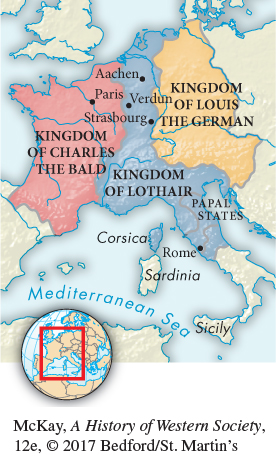A History of Western Society: Printed Page 237
A History of Western Society, Value Edition: Printed Page 225
A History of Western Society, Concise Edition: Printed Page 240
Invasions and Migrations FOCUS QUESTION What were the consequences of the ninth-century invasions and migrations?

Charlemagne left his vast empire to his sole surviving son, Louis the Pious (r. 814–840), who attempted to keep the empire intact. This proved to be impossible. Members of the nobility engaged in plots and open warfare against the emperor, often allying themselves with one of Louis’s three sons, who were in conflict with their father and with one another. In 843, shortly after Louis’s death, his sons agreed to the Treaty of Verdun (vehr-
After the Treaty of Verdun, continental Europe was fractured politically. All three kingdoms controlled by the sons of Louis the Pious were torn by domestic dissension and disorder. The frontier and coastal defenses erected by Charlemagne and maintained by Louis the Pious were neglected. No European political power was strong enough to put up effective resistance to external attacks. Beginning around 850 three main groups invaded western Europe: Vikings from Scandinavia, representing the final wave of Germanic migrants; Muslims from the Mediterranean; and Magyars from central Europe forced westward by other peoples (Map 8.3).